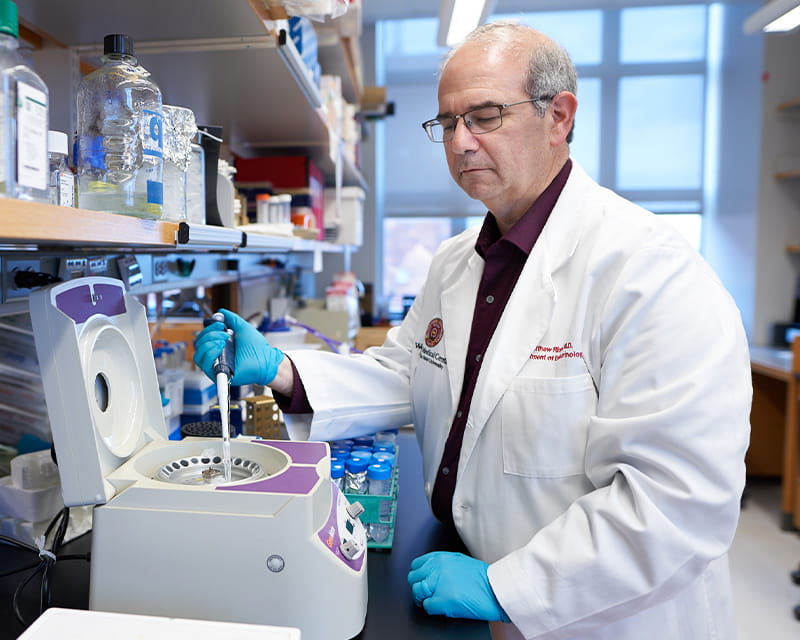
Studying “brake failure” in thyroid cancer metastasis
 In the early weeks and months of the COVID-19 pandemic, hospitals and health systems looked for ways to keep staff safe and preserve personal protective equipment (PPE). Intensive care units (ICUs) became testing grounds for innovations in patient care.
In the early weeks and months of the COVID-19 pandemic, hospitals and health systems looked for ways to keep staff safe and preserve personal protective equipment (PPE). Intensive care units (ICUs) became testing grounds for innovations in patient care.
At The Ohio State University Wexner Medical Center, a multidisciplinary team of providers came together with a focus on one of the most resource–intensive aspects of ICU nursing: care for critically ill patients with diabetes or high blood glucose.
A team led by Ohio State Wexner Medical Center endocrinologist Kathleen Dungan, MD, MPH, and nurse practitioner Eileen Faulds, PhD, APRN-CNP, began thinking about how they could use continuous glucose monitoring (CGM) within the ICU.
They believed that CGM had the potential to improve the care for people on IV insulin. CGM could decrease the number of necessary point-of-care blood glucose checks — reducing virus exposure, PPE usage and even nursing burden.
“Researchers have been studying the use of CGM in the inpatient setting for over 15 years,” Dr. Faulds says. “But studies have been small, used older technology and were often isolated to accuracy, not outcomes. When COVID-19 hit, it created a sense of urgency, propelling us and others to build upon existing literature.”
The Ohio State Wexner Medical Center team began meeting in late March 2020. And our timing couldn’t have been better. By early April, the Food and Drug Administration — together with the Centers for Medicare and Medicaid Services — gave approval for temporary off-label use of CGM devices in the inpatient setting.
“We worked fast, and within a matter of weeks had developed a protocol, gained approval, put a team in place and rolled out nursing education,” Dr. Dungan says.
Once operational, the team reduced point-of-care finger sticks by 70%, while still incorporating these tests regularly enough to validate CGM data. They also demonstrated improved glucose control among their patients.
“Incorporating CGM allowed for more effective use of IV insulin without the associated high-touch care, and with minimal increase in effort over insulin injections,” Dr. Dungan says.
Drs. Dungan and Faulds and colleagues published details on their program implementation in the journal Endocrine Practice. They also conducted an observational study of their protocol, which was published in The Journal of Clinical Endocrinology & Metabolism.
Drs. Dungan and Faulds admit the academic research world can be competitive, but they say the global coronavirus pandemic promoted a spirit of collaboration.
“When we first began discussing our ideas, we met with device manufacturers and reached out to a few institutions in New York that had seen a surge of COVID-19 cases much sooner than we did here in Ohio,” Dr. Dungan says. “Then, we submitted our protocol to COVID in Diabetes, an open-access site edited by Dr. Francisco Pasquel of Emory University. The site was created specifically for disseminating this kind of information to the health care community.”
That submission led to research partnerships with other academic medical centers and prompted use of the Ohio State Wexner Medical Center inpatient CGM protocol by many other hospitals across the country.
The team also says their work on CGM was done in concert with other efforts to reduce nursing exposure within their ICU. For example, where feasible, IV pumps were moved outside patient rooms for safer routine management.
While inpatient CGM was only approved for temporary use, Dr. Dungan, Dr. Faulds and others hope use of this technology inside the hospital continues.
The team is continuing to study CGM in the inpatient setting, not just in the context of COVID-19.
“No one would tell you that these devices are as accurate as fingers sticks or blood draws,” Dr. Faulds says. “But the total volume of information you gain through CGM gives you trends that you wouldn’t otherwise have with hourly checks.
“We’re still asking questions about when CGM is most safe to use, and for whom. But we think it has the potential to improve care and greatly reduce the nursing burden associated with some very time-intensive tasks.”